Me and My Friends #67 - Califaltication
Obviously I couldn’t stop at One Hot Minute.
If you’re somehow reading this entry first, this is the final part of a three part series, started here and continued here. This is basically an ultra-detailed version of this page here. You can read both, or just one, or none, depending on how bogged down into the details you feel like getting.
The major thing about this era is, being 4 years down the line and approaching the 21st century, everything has moved from cassette tape to CD-R. The method for sharing music quickly and cheaply has progressed. (I guess these days it’s all file sharing and private servers.)
Tapes are great, and they have their place, but a (well preserved) CD-R is instantly and endlessly sharable without any real degradation. No concerns about speed issues or hum or tape hiss here.
Let’s get stuck in. Here are all the different versions of Californication.
CALIFORNICATION ROUGH MIXES / “CALIFORNICATION UNMASTERED” (click to download)
One of the most famous (or maybe infamous?) bootlegs of all time. For those not yet initiated, the best bet is that this version of the album dates from early 1999, when the band were holed up in The Village recording studio, mixing the album. The name occasionally given to them is “rough” mixes, which is close enough for me, but they’re clearly close to final mixes, if not final, in most cases. It’s rough in the sense that something 95% finished is rough.
Most people still just call it Californication Unmastered. That’s where the Google SEO will lead you. You can see “Not Mastered” on the disc up there; that’s where that name has come from.
Some backstory: Almost immediately after the album was released it became evident that it was… loud. Too loud. Distorted. Crackling. “Are these speakers busted?” and etc. It was as if the album was always being played at too high a volume for comfort, even if you had it playing quietly. There are a thousand stories of people buying the album, liking it, but wondering why it gave them a headache if they listened to it for too long, especially on headphones.
The reason (one of several reasons) why people felt this is because the album was mastered too loudly. Louder equalled better.
Vlado Meller, who mastered Californication, gets a lot of blame for the way the album sounds. I know I’ve cursed his name my fair share. But Meller - who has mastered thousands upon thousands of albums over the years, including jazz and classical ones, and many ones considered audiophile quality - is a professional who does what he’s told to do by his client. He didn’t press a magic button, cackling evilly as he rubbed his hands together, and turn it into a big distorted mess against the band’s wishes. If you’re going to blame anyone, blame the band - and someone else, most importantly.
(This is probably apocryphal, but supposedly Californication was so loud that songs from it would trigger the in-house limiters that radio stations have in their stations. These were in place so nothing got broadcast too loudly, messing up listeners’ speakers. So, ironically, in the end, it wound up quieter anyway.)
In short, Californication quickly became, and remains, a (negative) poster child for the Loudness War, which you can read all about here.
The other poster child for the Loudness Wars is Metallica’s Death Magnetic. Rick Rubin produced that. Vlado Meller didn’t master it… You get my drift.
(For a while, there was a bit of a trend in releasing audiophile versions of albums along with their “regular” ones. Deftones did it in 2012, and Nine Inch Nails did it a year later. It doesn’t seem to happen anymore. I guess the problem was, it implied that one version was “less good.” Cut to 2025, and the Loudness “Wars” are basically over. Spotify and Apple Music, and most other streaming services - how most people listen to music these days - put their own normalizers and compressors on everything, so it doesn’t really matter how loud an album is mastered in the first place. Add things like the Apple Sound Check to the equation and - well, things are different.)
As we know from this interview with Chad, the band were pretty aware of the album’s reputation, and I’m sure John, in particular, wasn’t a fan of the final master. There’s a reason that, by 2006, he was insisting that Steve Hoffman, a mastering engineer famous for his gentle touch and audiophile tastes, deal with the vinyl edition of Stadium Arcadium.
This CD wasn’t just a “quieter” version of Californication; it was a whole different version of the album entirely - different track list, different mixes in some cases, and with far less compression (and in turn, less distortion). This was also the only source of “Fat Dance” for seven whole years before it popped up as an iTunes bonus track back in 2006.
You can use your ears or use your eyes. Here are wave forms of one song on the album, “Scar Tissue.” The retail on top, this alternate version below. I have converted everything in this letter to a singular mono file just to streamline things a bit:

To simplify it - a bigger waveform means a louder sound. If it hits one of the “roofs” of that little box, the sound becomes distorted, because it can’t go any further. It’s why, in short, this album sounds like it’s crackling at times: it’s the sound of distorted wave forms.
The wave form tells the visual story of the song; the guitar intro, the drums coming in, the drums stopping after the second chorus, the end of the song. On the bottom, you can see basically every single one of Chad’s snare hits. The dynamics are intact. When the band are being louder, the song is actually louder. On top, every sound is exactly the same. Take a look at the moment about halfway through, when the drums drop out and it’s only Anthony and the guitars for a few bars. You can see it happen in the version below. You can’t see anything change in the retail version.
Think of a band playing in a really, really, too-small, tiny room. One snare hit feels overwhelming. When they’re all playing together it’s unbearable. You can’t escape it. Every sound bounces off every wall and creates an awful din.
Then put the band in a bigger, more suitable room. They’re playing the same song in the same way, but you can step back and actually enjoy it. There’s room to breathe.
Now, the waveform being “smaller” doesn’t mean that the song is inherently quieter. It doesn’t turn it into the wispy little clap of a fairy in a dewy meadow. A bunch of distortion isn’t more badass and rocking. It just means you can turn it up. Here’s the original, 1989 release of “Stone Cold Bush” - nobody would ever accuse this song of being quiet or soft. There’s space in that little box.

Just for variety, here’s what the song “By the Way” looks like.

Not perfect, hardly an audiophile job, but a step back in the right direction by the exact same producer, mixer, and mastering engineer. Clearly, everyone seemed to realise that with Californication, they had gone too far.
This is a real rabbit hole. I mentioned it in my letter about the album last year, but you can get way too invested in this stuff once you start to notice it. What sounds better: a snare hit allowed to go where it wants, or a snare hit limited a bit with compression? A song squeezed into a box, so everything is contained all together homogeneously, or a song whose dynamics can change as the song requires? A little compression isn’t a bad thing. A lot certainly is. But… sometimes a lot actually is. A/B these versions over and over and after a while they all sound identical anyway, and you wonder why you’re even bothering. Maybe ignorance is bliss.
For those complaining about the retail version of Californication after its June 1999 release, suddenly, with this new disc, what was an auditory ordeal becomes… a regular rock album. Something you can blast on headphones and just enjoy. You can listen to things like "Get on Top" or the end of "Purple Stain" and not feel that fatigued, staticky, wash of white noise.
A lesser talked about moment is in the song "Californication," at the end of the solo/bridge and just before the main riff begins again. Chad really lays into his toms three or four times. In the album version… well, before I start repeating myself too much, go listen for yourself. The joy has been crushed out of it. You can barely hear anything. On this variant, it sounds like a drummer hitting his drums nice and loud. Just the way it should. There are a thousand other examples.
Sound of the album aside, there were a few other interesting aspects to this new Rough Mixes disc that made it stand out. Alternate track list and the inclusion of B-sides aside, some of the tracks were complete alternate versions. “Savior” had an extra set of lyrics before the solo, and there were vocals at the end. “Easily” had vocals over the guitar-orchestra outro. Anthony sang “ning nang nong” during every chorus in “Around the World,” instead of just the final one, and the outro was extended there, too. “Californication” had an extended first chorus.
We knew, then, that various edits were made to the album before it was released, because this early version contained all the stuff they cut out. It’s like an early cut of a film.
All those changes made to the album between recording and mastering can actually be seen in this document, written by Anthony, right here:
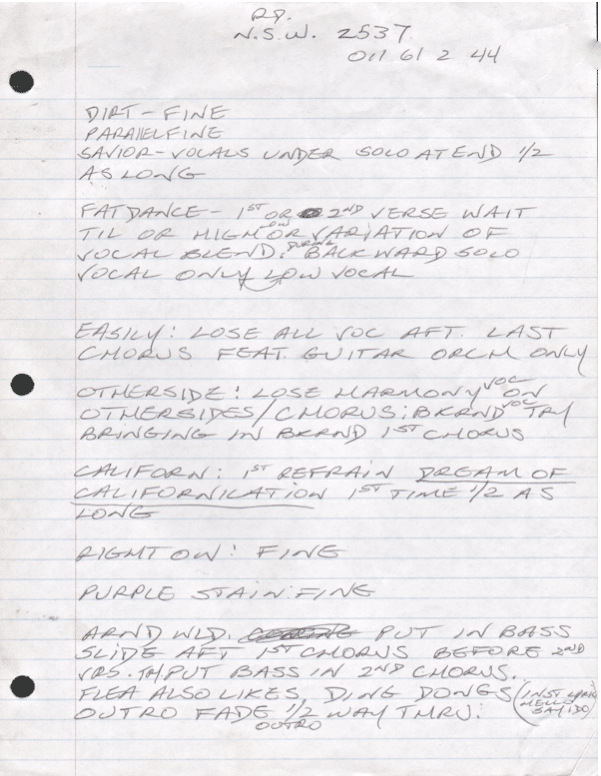
Easily - lose all voc after last chorus. Feat guitar orch only.
Savior - vocals under solo at end ½ as long.
Californ: 1st refrain Dream of Californication 1st time ½ as long
The Arnd Wld section I can’t quite parse. A bass slide moved, from after one chorus to before the second verse? They also seemed to be toying with fading the outro instead of cutting it, which would totally ruin the effect.
(This document’s very existence is stunning [thank you Louie!]; all I can think is about the stuff we haven’t seen.)
Back to the disc.
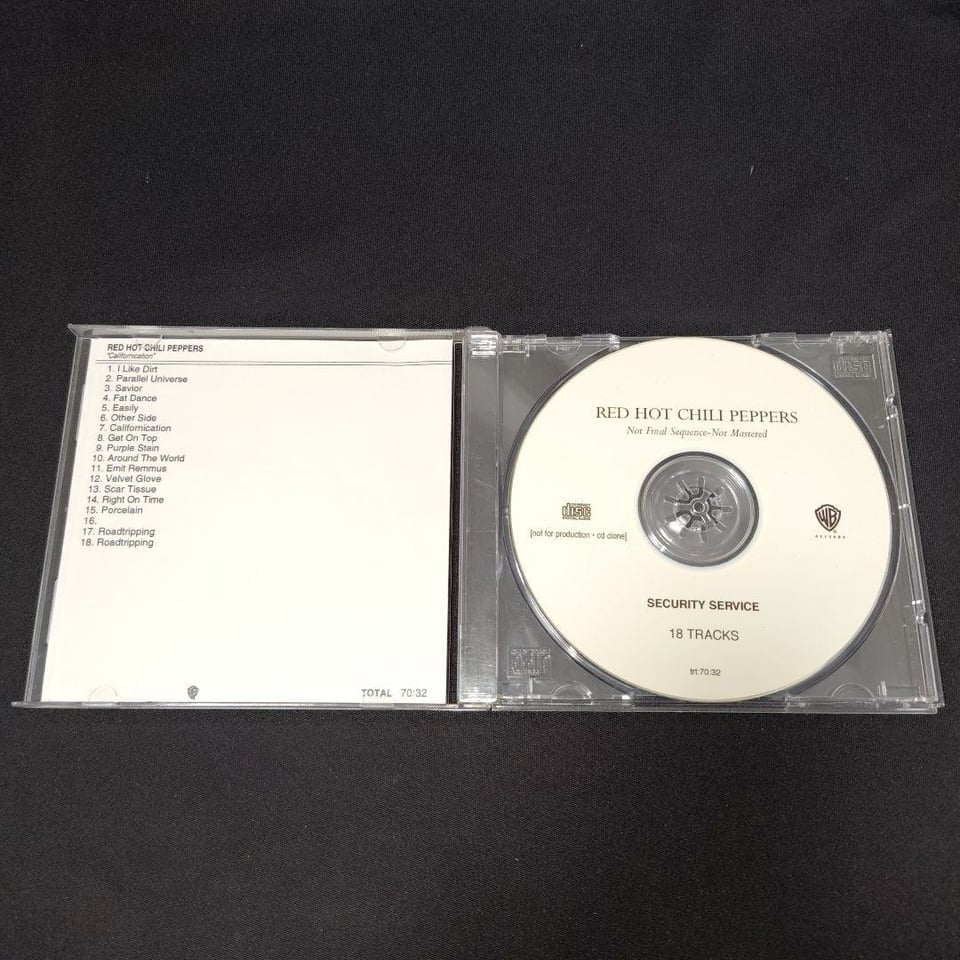
Here a Usenet poster mentions that it was Flea’s preferred version, which I always thought was a little too good to be true. A secret, better sounding version of the album leaked out by the band themselves? If they really cared this much, why didn’t they say something earlier?
Having now spoken to someone who was there at the time and actually received one of these discs, the same as the one you see above, it turns out that’s the truth after all.
The criticism of the album’s sound did actually lead Flea to send out a handful of CD-R’s to musician friends around Los Angeles. All the people that got that initial CD-R quickly shared it with their friends, and maybe even some people they didn’t like. By January 2001, rips and dubs had spread to the bootleg community, and the internet made short work of it soon after. I have been aware of it as long as I’ve been a Chili Peppers fan, which is well over 20 years now. A Google search will give you thousands and thousands of results. It was even turned into a full-blown bootleg with artwork you could buy at covered markets and dodgy record stores. It only circulated in 192kbps mp3 form until about 2011, but now it’s out there (and up above) in glorious FLAC.
The photos of this disc are sourced from a Japanese auction that only happened a couple of months ago, though the disc itself was discovered in a Santa Monica record store back in 2001. I can say with 1000% certainty that I would have paid the couple of hundred dollars they were asking for it, just to own this weird little piece of history.
For years - decades - until I started writing this letter, I had never seen a photo of the disc itself, or the inlay.
I was astonished to see that the date of its manufacture, listed on the bottom right of the inlay, was August 30, 1999.
Almost three months after the album came out.
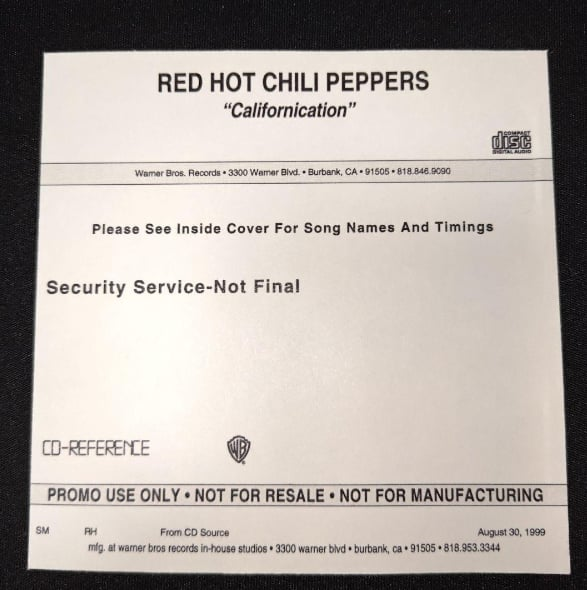
Until then I had always assumed it was something made for the band in early 1999, before the album came out.
Why would the Warner Bros. in-house studio be manufacturing and distributing a completely alternate version of Californication in August, when the album came out in June? Which outfit would need a promo/not for resale version when the actual final thing is sitting in stores already? Who needs a reference or test copy when the thing is already finished?
This is a guess, but I think it was Flea who requested this from Warner Bros. It was 1999, he didn’t just have a spindle of blank CDs or a CD burner lying around to do it himself (he was on tour anyway).
This specific version of the album had to have been chosen for a reason. You can see it says “From CD source,” up there, meaning it was copied from something existing lying around, instead of being from a tape, like some of the other discs in this letter are.
Maybe it was an earlier draft of the album. Something the band prepared at some point and rejected, for whatever reason. But, because Flea knew it sounded better, months down the line, it came to mind. As we’re about to see, the band tinkered with the album over and over again before they finally decided it was finished.
I believe the running order of this disc is an early attempt at a track listing. Maybe never considered final, but an early… idea. On the disc it says “Not final sequence,” but that doesn’t mean it’s not an early sequence. A rough draft, if you will. It’s like when you move into a new house and you dump the boxes into each room, vaguely. Things might change, but a lot won’t. There’s an early shape to things.
There are a couple of reasons why I think this is the case, and they’re similar to the “early sequences” in the previous letters.
Firstly, “I Like Dirt” in the opening position. The band used to open shows with it, and it seems likely they were thinking of it also opening the album at some point. That ba-bum…ba-bum popping out of the ether is a great way to begin, no? It’s also a short, kinetic song, and probably one of the first songs the band wrote with John back in the band. It Makes Sense. Then you see “Parallel Universe” in the second position, and “Road Trippin’” in the final spot. Can it really be a coincidence that these are both in the same exact positions they wound up in on the final album? Maybe. But probably not.
It’s hard to imagine “Around the World” being that far down in the track list - it’s a natural opener, right? - but I suppose that’s only because we think of it as an opener now, that’s what we’re used to. It didn’t need to be, and it wasn’t always played first live, either. “Can’t Stop” is a natural opener now, and I can’t really picture it played anywhere but first slot of a concert. It’s track 7 on By the Way! At Slane Castle they played it fourteenth! Some real cereal for dessert type stuff.
You’ll notice a name for track 16 is missing. That’s “How Strong.” Maybe it didn’t have a proper name at this point (it was released in 1999 on the Australian bonus disc and the Otherside single [and on this release] so that’s unlikely). Maybe it’s a security thing. Leave a name off, and when that song leaks without a name, they know who leaked it. Otherwise I can’t think why it’s like that, apart from it just being a boring old mistake, or the original disc that this was copied from didn’t have a name for it listed.
We know it isn’t a completely separate (and then rejected) master, or a complete version of the album they actually contemplated releasing and then put the kibosh on for whatever reason. It’s definitely unfinished, and rough in places. There’s a nasty click at the end of “Emit Remmus” which would have never reached the retail edition, and “Otherside” and “Parallel Universe” have tape noise pop in and out at the end like they accidentally left the machine on too long.
And, of course, there’s the two versions of “Road Trippin’” - as nice as it is, once is enough.
This is why I think “Rough Mixes” is the best way to describe this release. It was the album as it stood around the time Anthony wrote that piece of paper, and they made a few more edits to the final product.
And although I think this version of the album sounds good, and is probably the best (or equal-best) sounding version of the album, I don’t think it sounds all that great. It sounds “better” than the retail version in that it’s not overly compressed and distorted, but I do think it could sound even better. It’s a little tinny to my ears and a little light on bass. It’s clearly unmastered. A lot of this is the album’s mix, but more on that later.
Here’s the waveform for “Emit Remmus” from this collection. Again, I’m asking you to look at some blue lines on a screen here (it won’t be the last time), but bare with me.

Notice how the bridge - about three quarters is of the way through - is slightly louder than the rest of the song? That isn’t right. If anything, the final chorus should be the loudest moment - it’s what the whole song is leading towards, after all, it’s where everyone is playing their loudest.
Same goes for “Otherside,” below:

Again, some of the earlier choruses are far louder than the final chorus. The whole song is about building to that final chorus! I won’t bore you any further with details, but it doesn’t look right, and a finished record wouldn’t look like that, and for that reason alone the idea of them being rough mixes makes more sense than anything else.
So why did this disc, specifically, re-emerge?
I have nothing concrete to back this up, but I think at one point, during the Californication mixing or mastering sessions, Flea went back to his native Australia. You can see, written on the top of that piece of paper, is the end of an address for a property in New South Wales. The postcode of 2537 covers the location he used to own a house in, and the 011 61 2 is the beginning of an Australian phone number, too. (Both have been blurred by the original uploader.)

Why else would they be taking note of his address and Australian phone number if they weren’t about to use it, i.e. if Flea wasn’t around (or was preparing to leave) at this point?
Is the “Flea also likes ding dongs” also written about him as if he wasn’t there, perhaps? Perhaps.
The Rough Mixes CD dates from prior to these changes being made, of course, because the songs are in their original form. So, maybe it was something Flea took to Australia, or became acquainted with in some way.
Just a guess. But six months later, when the album was out and he was hearing, over and over, that it didn’t sound very good, maybe he thought about this specific CD, knew it sounded better, and decided to disseminate that one instead. Flea, if you’re reading this (I know you’ve read other letters!) please put me out of my misery.
CALIFORNICATION UNMASTERED UNSEQUENCED (click to download)
This is the real curio of the bunch, because you’d expect it to be the same as the “unmastered”/Rough Mixes disc above. Instead, it appears to be somehow basically identical to the Rough Mixes, sound more like the final version, and is partly, barely, a different set of mixes at the same time.
I bought and released this disc back in 2011 at the same time as similar BSSM and OHM tapes.
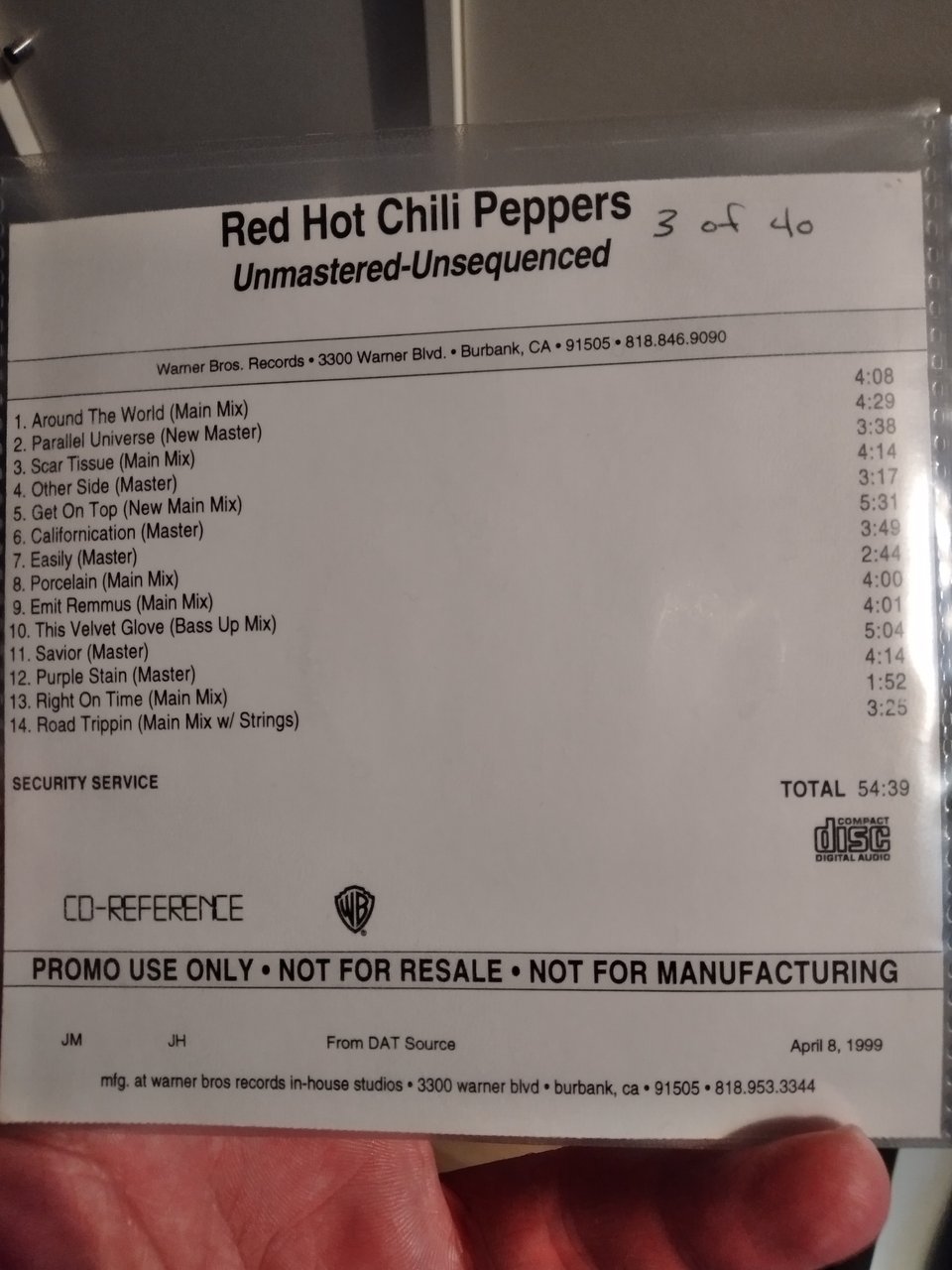
Virtually everything else on the album is the same as the Rough Mixes - the extra verses and vocals and beeps in “Californication” and “Savior,” etc. “Around the World” has the proper chorus vocals, but the extended outro, because that hadn’t been snipped yet.
The big surprise for me the first time I heard this was that there was an extra run-through of the first chorus in “This Velvet Glove,” which isn’t present on any other version of the album anywhere.
As you can see, this is dated from April 8, 1999. This is probably the second-last draft of the album before it was sent to mastering. Everything is in the correct order, everything is basically where it should be. The album was seemingly mastered in mid to late April. I say that because finished, final copies of the album - seen in, for example, this promo - are from April 30.
I think these are final mixes, and the stuff that got edited out - the extra verse in “Savior,” the extra run-through of the chorus in “Californication” - got done during the final mastering session. It’s easier to chop it out at the last moment, I guess. “Easily” is missing the vocals in the outro, because that’s a change made at the mixing level. You can’t cut out background vocals without cutting the rest of the song.
This disc is strange for other reasons, though. Let’s add another waveform to the pile. Here’s “Scar Tissue” again. Final retail on top, the Rough Mixes (or “Unmastered”) that you saw up-page in the middle, and this newest one on the bottom. Hopefully this is all starting to make sense.
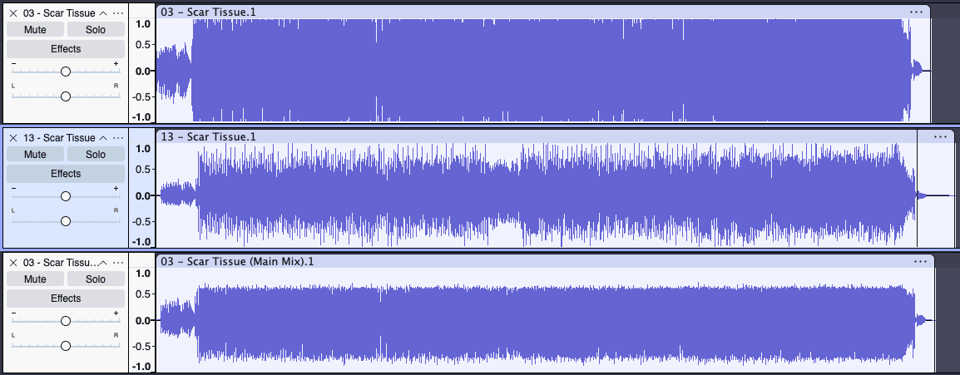
Now, the bottom one might be “quieter,” but it’s hardly dynamic, is it? Once the drums come in, the whole thing is a squished block. It’s basically a rectangle, which isn’t how music is supposed to sound.
Here’s another waveform. The retail on top, and this new one on bottom, but I’ve reduced the volume of the retail version by a couple of decibels, so they match.

Basically the same, right? The bottom one has a little more variation in its peaks, I think because it’s (according to the inlay) from a DAT source, which maybe wouldn’t export out a perfectly straight line, the same way that even brand new tape would be a little wonky, if even imperceptibly.
So why is something “unmastered” still so compressed? I think when they finalized the mixes, they ran it through some sort of compression as a final… sweetener. No wonder the final master is so rough; they’ve been squished in the mixing stage!
This is from a 1999 interview with Jim Scott, who engineered and mixed the record:
It wasn't like there was anything to fix in the mix. All I had to do was balance it right and make it really loud. So mixing was easy.
The word “loud” appears 11 times in that interview with Scott. Loud loud loud, loud, loud loud loud, loud. Loud. LOUD! And we wonder why the album was LOUD?!
This is why the original vinyl release of the album sounds so bad, too; it’s not just the final master that was compressed. I mean, it was compressed further, but it was already compressed. All that compression and distortion was baked in before it even got to the mastering engineer, and all Meller did was add another round of pain to it all.
Even the Rough Mixes versions of the songs are about as loud as a regular rock album. If they were already at their limit before it went through two rounds of compression and mastering, is there any wonder the final thing sounds so bad?
Now I come to you with the curio. If the reasonable suggestion is that the order of all of these versions goes: Rough Mixes > Unmastered/Unsequenced > Retail - why does “This Velvet Glove” have an extended chorus in this version only?
Something similar came up in my letter about BSSM and the odd mixes of “Sir Psycho Sexy” and “Under the Bridge.”
I can only guess that the chorus was edited previously, re-instated at this stage, and then finally edited back out again in mastering. “Didn’t we cut this already?” “Oh, I guess we did. Cut it again!” and so on. Who knows. I have a feeling I am genuinely putting more thought into this now, in 2025, than the band themselves did, in 1999.
I should clarify what I mean when I’ve been saying “unsequenced” over these last few letters. After all, this is the same track list as the final album. Is this not sequenced?
Well, yes and no. Sequencing isn’t just the act of deciding which songs go in which order.
Notice, when you’re listening to Blood Sugar, how those last three notes of “The Power of Equality” bleed exactly into “If You Have to Ask”? Or how you can hear “Give it Away”’s count-in and “Crank it, that’s it,” at the end of “The Righteous and the Wicked”? That’s sequencing. It’s the act of lining up, exactly, how the tracks interact with each other on the finished product.
Californication doesn’t suit itself to the same seamless-ness that Blood Sugar or One Hot Minute has, though, so the act of “sequencing” isn’t as noticeable. Maybe you could have a bit of fun with cutting out the silences and shoving the songs together. Maybe “Parallel Universe” could be smushed right up into the end of “Around the World.” It kind of already is.
The little drum roll Chad does at the end of “Fat Dance” is something that, during sequencing, they’d probably cut out. The same goes for the end of “Quixoticelixir.” Not that either of these songs made the album anyway.
Now you know!
CALIFORNICATION B-SIDES CD-R (click to Download)
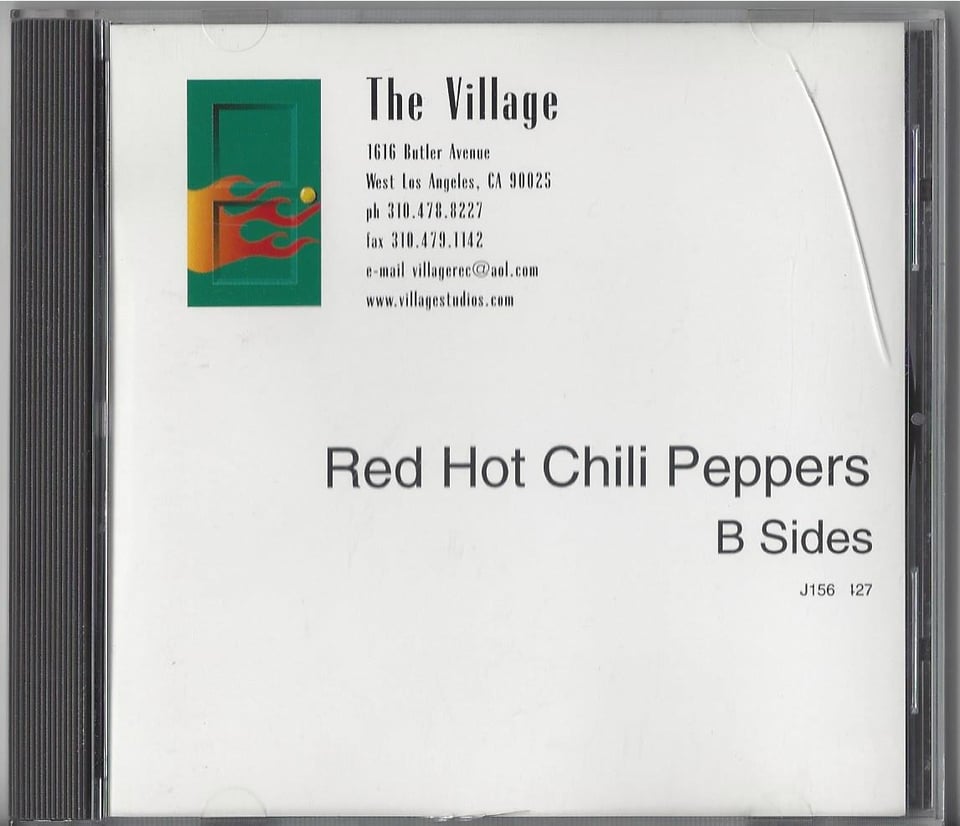
This disc is dated April 21, 1999, a few weeks after the Unmastered/Unsequenced disc above, and as you can see, is specifically referred to on the cover as “B Sides.”
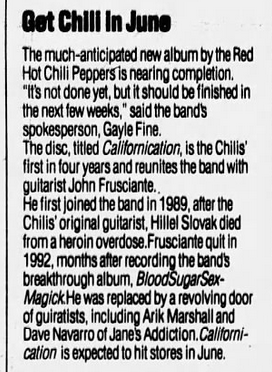
In early April, the album was still unfinished. (OG heads remember Gayle from the official forum back in the day.) This disc is dated a few weeks later, so the timeline matches. By this point, they knew what was making the album (in fact, they already had the final track list), and what was being cut.
Of the 7 songs on this collection, only 3 were actually released during the album’s run. Weirdly, “Fat Dance,” “Quixoticelixir” and “How Strong” are missing from this entirely. Why? Great question. Maybe they had been mixed already, and these were the only songs yet to be completely finished. I think the reason this was created was so the band could pick B-sides for the forthcoming single release of “Scar Tissue,” but I’m not certain.
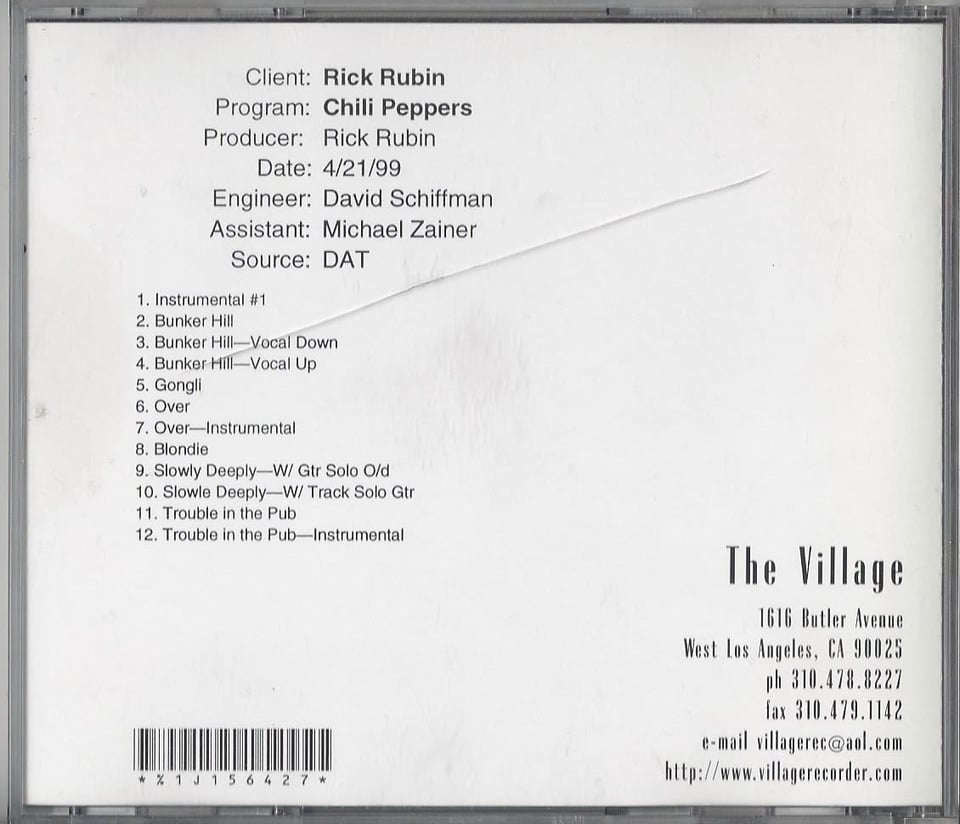
“Instrumental #1,” “Gong Li” and “Blondie” (or “Instrumental #2,” ahem, more on that below) were released throughout 1999 and 2000. “Slowly Deeply” got dug up in 2003 for the Universally Speaking single (the “Gtr Solo O/d” version got picked in the end) and “Bunker Hill” for Fortune Faded later that year (with some additional overdubs, which may have been done in 1999 - but when? - or which may have been done in 2003).
“Over Funk” finally emerged in 2006, slotted on to the end of the Californication Deluxe Edition (the vocal version, even if it was a guide vocal full of unfinished gibberish, was deemed good enough). “Trouble in the Pub” remains officially unreleased, and seeing as it’s basically a less interesting “How Strong” with full minutes of aimless wandering interspersed, you can understand why (the shorter, tighter “Teatro” demo version of the song is much more successful, in my opinion).
When this disc leaked in 2014, coming with it was the revelation that “Blondie” was actually “Instrumental #2.”
“Blondie” was considered a “Holy Grail” for a long time (it’s nice how many of these have since been crossed off). Up until this point, our only knowledge of the song was this little interaction between John, and Australian fan Simon Howson in Adelaide airport during the band’s tour.
Incidently, RHCP recorded a song that had a working title of BLONDIE during the Californication sessions, but doubt it will ever be released :-(
It was February 2000 when this interaction took place, so “Blondie” had been actually been out for more than six months. It had even been released in Australia specifically. I figure the name “Blondie” was rejected so it could line up with “Instrumental #1” better.
Being a pretty big fan, I’m guessing Simon bought that edition, or was at least aware of it. He’s the one, through this interview, that brought knowledge of “Blondie” to the world. Little did he know there was no need for that frowny face emoji - they’d already released it! What’s even stranger is that John seemingly had no idea. You’d think the band would be made aware of these things, but maybe not. Did he just forget, or did he never know? The inner workings never fail to intrigue me.
The tracks on this disc are unmastered, and I mean truly unmastered. These are probably the rawest version of the album we have. Take a look at this wave forms - even less compressed than the Rough Mixes! This is from a DAT too, so I don’t think the songs coming from a DAT is the reason the Unmastered/Unsequenced disc is so compressed.

These are worth a cursory inspection, but are mostly inessential curios in the grand scheme of things. The alternate solo in “Slowly Deeply” doesn’t work as well, and “Bunker Hill” lacking some overdubs makes it less complete sounding. The fact they’re basically completely uncompressed and unmastered means you can have a bit of fun being your own Vlado Meller for an hour or two, but that’s about it. Moving on!
POST-RELEASE VARIANTS
Californication is unique in that it has variants that popped up after the release. They might have finally dragged the album over the finish line in 1999, but that hasn’t cemented a certain exact version of the album as The One that they’ve gone back to in the years since.
It seems as if, when someone needed to dig back into the WB Archives and take out the Californication masters to be used for whatever reason, the wrong mix has been occasionally used.
Seems bizarre, but I think I’ve actually just explained how something like this can happen. You might have done something similar when you’ve finished a large creative project or school assignment of your own. Your desktop is filled with files like FINISHED and FINISHED_FINAL and FINISHED_ACTUAL_FINAL and FINISHED_ACTUAL_FINAL2_USETHISONE.
Take a look at this interview with Ryan Hewitt, talking about his mixing of “Black Summer” in 2021. Nestled into the very end is this paragraph:
John also wanted to hear the mix without the piano part, which became mix 3. Rick had a few changes, and we tried some different EQ on the guitar. I think we got up to mix 6 or 7, and then we all sort of realised that mix 2 was the best one. I did a recall for mix 2, because we wanted to make some minor adjustments to it, but the recall did not feel like mix 2. It was a very subtle difference, but everyone agreed that the original mix 2 was better.
All 7 of these mixes are still sitting in a tape vault somewhere. It’s not unthinkable that when they dig back into the archives for whatever reason, they’ll accidentally use mix 3, or mix 6, and there’ll be confused comments about this version sounding weirdly different. The same thing probably happened to cause that random alternate version of “Universally Speaking” to emerge on a one-off compilation a few years back. I think the same thing has happened to Californication.
1999/2000: “Around the World” and “Californication” singles
I genuinely had no idea about this until I was writing this letter. There’s basically nothing worth writing about here but, hey, if you’ve gotten this far…

These are the same mixes as the retail editions, just turned down a few decibels. Essentially it’s the same constantly loud versions of the songs, but… smaller. Zoom in real close and you can see little moments where the waveform does its best to extend past the limit imposed on it. “Around the World” has similar things happening. They sort of remind me of solar flares bursting from the sun randomly.
I have no idea what the reason behind this is. Reducing the final master by a few decibels doesn’t fix anything. It’s just a tiny bit quieter. The versions on the “Scar Tissue” and “Otherside” are identical to their album counterparts. Strange! But now we know.
2003: Greatest Hits
Five tracks from Californication popped up on the Greatest Hits compilation (including “Parallel Universe” which was in no way whatsoever, in no country on the planet, a “hit,” but okay!).
These are alternate masters - they didn’t just rip a CD and re-use those tracks. They went back to the master tapes. There’s nothing drastic here, but it’s different enough that it’s worth noting.
Here’s the song “Californication.” Squint real hard and you’ll see it’s a little less compressed than its retail counterpart. But at this point it’s a bit like throwing an ice cube into a volcano.

“Californication,” the track, itself, is a doozy. There are three “official” mixes of the song, and they all differ in only vaguely noticeable ways. As you can see above, the GH version is a little longer. Every pre-Retail version of the song has two runs through the first chorus. I think the cut is a good addition (or subtraction) to the song - it makes it build a bit better when the first chorus is shorter; the later choruses are more impactful this way because they really stick around. They probably cut the first chorus in “This Velvet Glove” for the same reason.
As I said above, it seems as if some of the edits the band made to each track actually happened when they mastered the album, all the way at the end of the process. So when they pulled the finished mixes out to master them again, like here in 2003, what got accidentally used was the original, extended version of the track. Whatever note that said they had to cut the first chorus in the future, if they were going to master this again, got misplaced or ignored. If “Around the World” was on Greatest Hits (like it really should have been, I mean if “Parallel Universe” was a “Greatest” Hit then… no, I won’t get into it…) there’s a chance it would have been an alternate version as well. But I’m not 100% sure about that (I’m not 100% about any of this!).
There are also several different versions of the title track with regards to that little organ part that plays throughout the song. In some versions, like the retail, there’s a lonely little beep at the “it’s the [edge of the world]” line in the first verse, then it properly pops up before the second verse vocals. In some versions, like the Unmastered/Unsequenced disc, it appears in the first verse, right when the drums come in.
I’ve always figured the band were never quite happy with it; they knew it added something but where should they put it? They kept moving it around and around, and adding it and removing it, and in the end, they never actually decided which was the final version.
At some point in about 2010 it became evident that the version of the album then available as a digital download was a slightly different master to the retail edition. This is the “deluxe” version that emerged just before Stadium Arcadium was released, with “Quixoticelixir” and others as bonus tracks. It was nothing drastic. The fact that it had been out there since 2006 but took 4 years for anyone to notice says it all, really.
It was only when I was writing this letter that I noticed what had actually happened. Weirdly enough, they’ve slotted in the Greatest Hits masters of the songs into the full album. Tracks like “Easily” and “Savior” and so on were exactly the same, but “Scar Tissue” and “Otherside” were barely, but yes, noticeably, less compressed.
Here’s “Scar Tissue.” Retail on top, Greatest Hits in the middle, 2006 “deluxe” version on the bottom.

Notice anything? The bottom two are the same. Why did this happen? I have no earthly idea.
The track markers for all the songs are sliiiiighty different. So it is a different master. But I’m getting too bogged down in the details as it is, so let’s move on.
2012: Vinyl remaster (click to download)
This is, pound for pound, the best sounding version of the album. It was remastered in 2012 by Chris Bellman from the original tapes and pressed at a high quality plant on heavy vinyl, yada yada, you get the drill. I think pbthal did this rip, and he’s the best in the business. People always say they wish Steve Hoffman was given the opportunity to master the album. This is the next best thing, if not better, because Hoffman is retired now anyway.
It isn’t perfect. It’s a vinyl rip, so there’s a layer of separation between you and the music that some people tend not to like. And if you don’t love the way the album sounds in general, no mastering job can fix it. The mixes suffer from the same s q u e e z e that afflicts every post-Rough Mixes version of the album. But this is actually mastered, and finally, with a good turntable (or this rip), you could listen to the album as the band intended, in the correct order, with artwork, on a legitimate release. The choruses even get louder, when they’re supposed to, in the right places!
Take a look at “Right On Time.” Breathing room - at last!

But it wasn’t that easy, because nothing about this album is. Instead of this simply being a better-sounding release of the final, retail-edition of the album, again there were some variations. “Californication” had the correct amount of choruses, yes, but the organ still appeared more than it did in the retail edition; it pops up right when the drums do, like the Unmastered/Unsequenced disc. Another alternate. What people noticed the most was the outros of “Easily” and “Savior” being their alternate, extra-vocal versions.
At this stage, the only thing that makes sense is that the Warner Bros. tape library hadn’t clearly marked which version of the album was the final, official, approved mix. Songs like “Scar Tissue” and “Porcelain” didn’t matter, because there was only one version of the finished mix anyway. They just took what was there. But songs like “Californication” or “Easily” had alternates upon alternates, and these alternates aren’t obvious if you don’t know where to look.
Thirteen years after the album was released, and yet another occurrence of the incorrect versions of a song being used. But what does incorrect even mean anymore?
But - hey, maybe they’ll fix it the next chance they get?
2014 digital remaster
In 2014, the band’s entire WB-era catalogue was re-issued in high resolution and released in places like HDTracks or Qobuz.
This version of the album is what you are playing on streaming services today. You might notice that there’s the album itself, called the Remastered version, and then the “(Deluxe Edition).” The album itself is this new 2014 remaster. The “(Deluxe Edition)” is the 2006 version, which as I mentioned above, I think has the 2003 remasters of certain tracks slotted in.
Here’s how you can tell, with some more musical technology terminology for those that don’t know it:
A CD plays music at a bit-depth of 16. The more bits, the more… well, information. When you think of “8-bit music,” you’re thinking of glitchy, “chiptune,” NES-style music, right? 8 bit music has 256 possible values. 16 bit music has 65,536 possible values. It’s an exponential rise. It’s as many bits as you need to recreate human-made sounds, like a rock band in a recording studio.
A CD also plays at 44.1 kHz. This means that, for every second of 16 bit, CD-quality sound, there are 44,100 samples being played. Because of the Nyquist sampling theorum (you can read this in your own time) this winds up being the equivalent of 22,050hz per second. Human hearing only goes up to about 20,000hz, slightly under the capability of a CD.
So a lossless CD - a 16bit/44.1khz file - is, essentially, all you really need. There’s a reason it was chosen as the standard by the CD manufacturers all those years ago.
But even a 16/44.1 file is only a fraction of the possible information on any given recording. An analogue master tape has essentially endless capabilities, and a CD, as good a job that it does, deletes a lot of that possible information on its way to being 16/44.1.
Most master files will be much higher resolution, like 24 bits/96 kHz. You can go up to 32/192 and beyond. It’s a bit (not a pun) like a film being stored in 8K resolution; far beyond what you can hear, see, or even reproduce, but it’s the safest way to store it - in the highest quality possible.
Having said all this, albums like Deathconsciousness by Have a Nice Life or Royal Headache’s self-titled were mastered from mp3 backups, and that didn’t affect things too much. An mp3, which is about 60% of the quality of a CD, is good enough, and has been good enough, for literally billions of people, for many decades.
Over the years, high resolution consumer audio has become more and more prevalent. That’s why places like HDTracks or Qobuz exist. It’s why Tidal has the reputation for being the “better-sounding” streaming service. It’s why it was genuine news when Spotify announced they were going to finally start letting you listen to what they consider as lossless audio.
If you are listening to the reissue version of Californication on, for example, Apple Music, you’re listening to it in 24-bit/96 kHz. (Unless you’re listening on Bluetooth headphones, most of which are inherently lossy, and of course, most computers don’t have the capability to play 24/96 natively anyway… hey, did I mention the rabbit hole yet?) If you’re listening to the original, by which I mean, the 2006 (Deluxe Edition) version, it’ll “only” be in 16/44.1.
A 24/96 file contains information far beyond the limits of human hearing, but those extra bits and samples may as well be there. It’s 2025, after all; we can afford it.
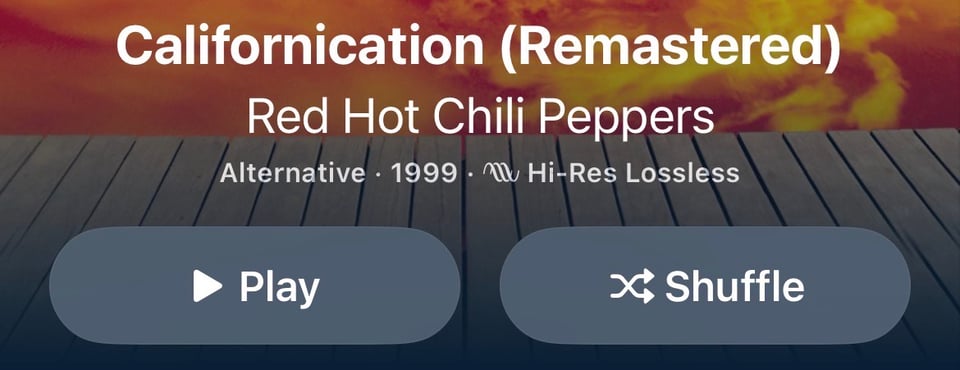
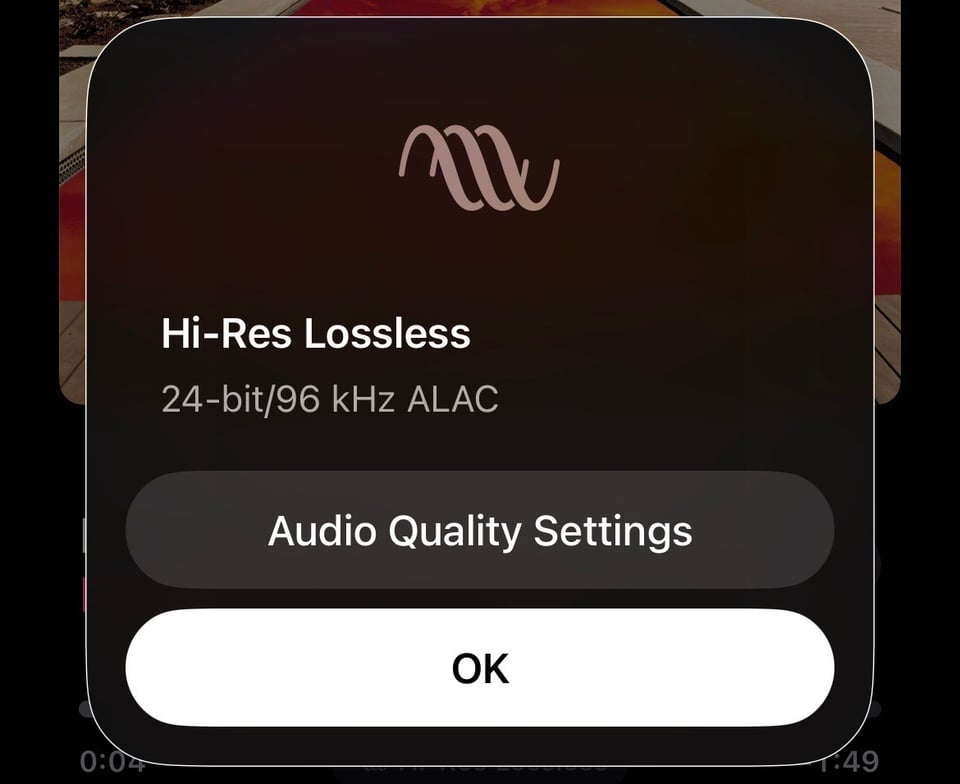
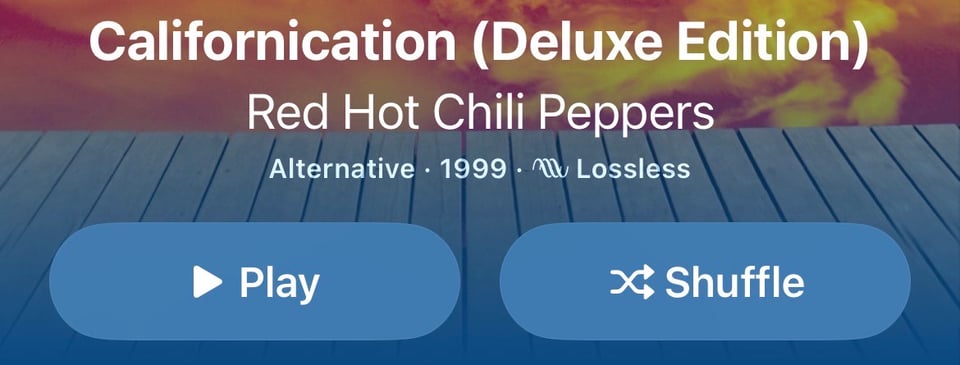
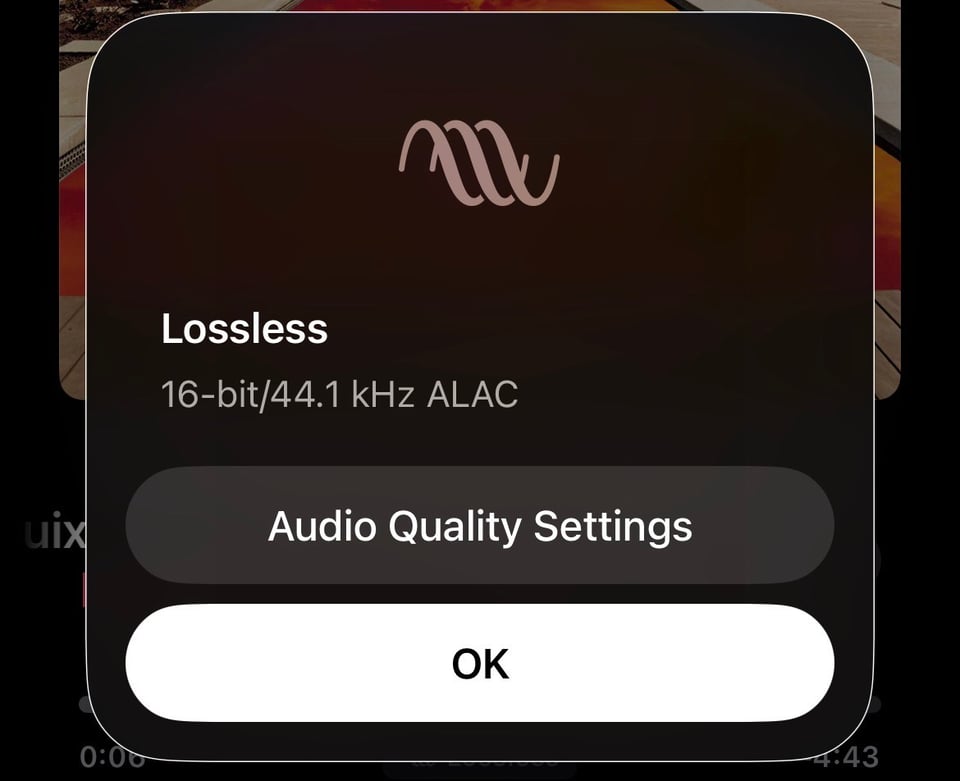
Instead of a wave form, I’m going to show you a spectrogram. This is similar to a wave form (it’s from the same program!), but shows you essentially how high or low the frequency of any given moment of a song is.
This is “Parallel Universe” - the first half is the 2014 24bit/96kHz version, the second is the retail 16/44.1kHz CD version.

That drop off - where the cliff of pink and red arrives - is the difference between the file waiting for you in a 24/96, “Hi-Res” file, and the file on a CD. All that extra information is at the highest end of the frequency, meaning most of it is beyond your ability to hear anyway.
There is undoubtedly more information in a 24/96 file, yes. But I’ll remind you again that 20,000 hertz is the extent of the human ear’s capacity. You can see the 16/44.1 version, on the right, going up to pretty much 20,000 hertz. The 24/96 version goes past it… and then…? Well, there’s a bit of info there, right? Enough to notice? That’s up to the listener.
I’ve read occasionally from some audio engineers that they aren’t too fussed with sample rate, and would instead prefer more bits. In other words, a 16/96 file would be pretty much useless padding, but a 24/44.1 file, they can actually tell the difference in. This graph doesn’t show the difference between 16 and 24 bit audio. I guess you’ll just have to go down your own rabbit hole if any of this is interesting you.
Now, I must admit that I’ve just made you sit through all that terminology for no reason. Because this 2014 remaster of Californication is essentially the same as the 1999 retail. First of all, it’s only barely, barely, less compressed than the original - removing all point of a remaster in the first place. They had their chance, and they didn’t do anything to fix the compression distortion.
All of the little alternate possibilities, like the extra chorus on the title track or the outro vocals on “Easily,” are missing; they’re like they are in the retail edition. The only way this version differs from the retail is that “Savior” has the “all in a hand” vocals in the outro, over the solo; at this stage the only version of the album that doesn’t have them is the 1999 retail edition.
The reason I bring any of this up at all is because you can actually tell, with this latest version, that someone has gone through and made sure those same mistakes from earlier, such as the 2012 vinyl master, didn’t happen again.
This is “Californication.” It’s a 24/96 file. I’ve made zero adjustments to this:

Let’s look a little closer at the beginning of the song:

See those cliffs? Remember how a CD quality, 16/44.1 version of a song looked?
I’ll show you another song. This is “Easily.” Remember how, in the 2012 vinyl edition, there were vocals in the outro which weren’t “supposed” to be there?

See it yet? Here’s a close up of the end.

Exactly when the outro begins, the song loses all of that extra, high-end information. Long story short: whoever prepared this master of the album sliced in the CD version every time there was a difference they needed to patch up. The CD version, of course, only goes up to 20kHz.
The same thing happens in “Californication.” The sliced in parts, just when the drums start at the beginning, are from the retail edition, because that’s the “proper” version that doesn’t have the organ part.
None of this is audible, it’s a totally seamless cut. They’re professionals, after all.
What does this all mean? It means, finally, after almost two decades, someone within Warner Bros. actually took the time to fix these endless little variations. Chris Bellman, who mastered the 2012 vinyl edition of the album, also mastered a later, 2024 edition. According to this interview, in 2012 he was given the actual master tape, but in 2024, it was just a file.
Maybe, after twenty five years, they finally decided on a final version.
You can keep track of virtually every version of the variants above, in this image, done by friend of the page Hunter Gordon:
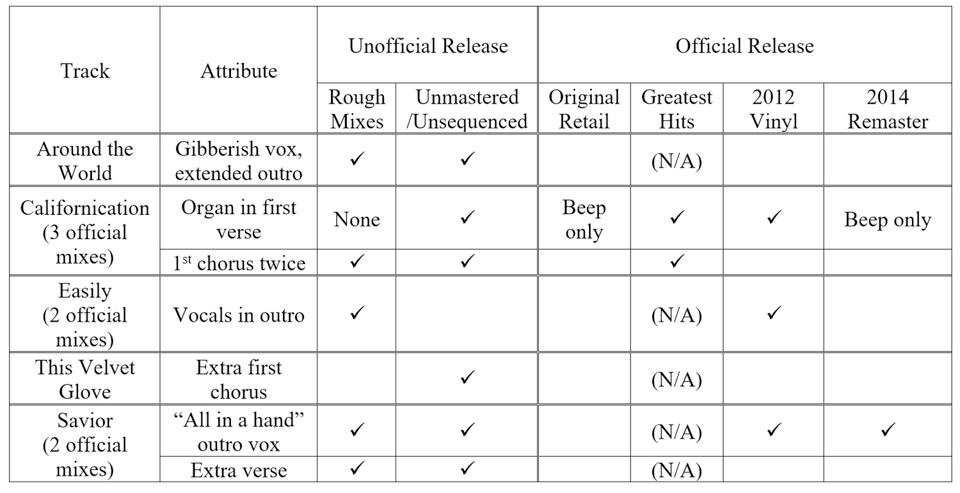
This is the song “Easily.” Click on this wearing good headphones, or with your computer connected to good speakers. It’s the:
retail version of the song for 15 seconds, then it’s
15 seconds of the Unmastered/Unsequenced version of the song, and then it’s
15 seconds of the Rough Mixes version of the song, and then it’s
15 seconds of the 2012 vinyl remaster version of the song, and then it’s
15 seconds of the retail version again, as it fades out.
I have done nothing to any of these files. Just lined them up. The levels are all exactly as they are on the disc. They are all lossless.
Listen to it once or twice before you read this next paragraph…
I think everything I’ve said about the auditory quality of each version of the album (and in turn the auditory quality of each, and thus, this song) is evident here: The fact that the retail is distorted and loud, but actually mastered; that the Unmastered/Unsequenced version is weirdly still very compressed and yet quieter, and clearly unmastered and just generally pointless; that the Rough Mixes version sounds “good,” yes, but is missing that final sweetener that any mastering engineer would give it, and that the 2012 vinyl edition sounds quite good, because it’s mastered but not overly compressed, even if it is inherently less perfect, because it’s a rip of a record.
I picked this song because it’s got dynamics, it has a snare crack you can follow, it has distinct bass and guitar parts. It’s up to you which one sounds the best. I think the vinyl version does. You might disagree.
Thanks for reading.